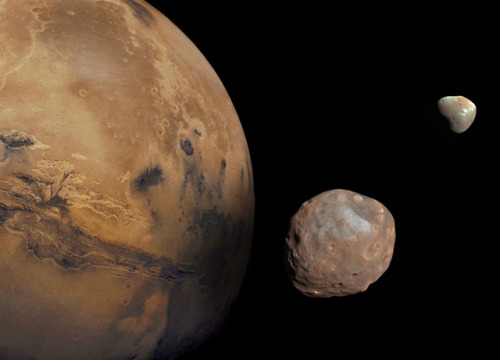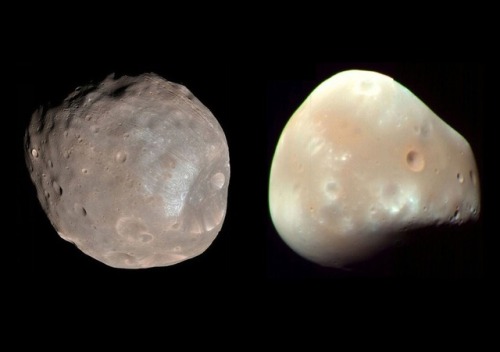(Source)









(Source)
More Posts from Ocrim1967 and Others









‘’A God’s Eye View of the Universe’‘
Credit: SpaceRip
Stellar Winds
Stellar winds are fast moving flows of material (protons, electrons and atoms of heavier metals) that are ejected from stars. These winds are characterised by a continuous outflow of material moving at speeds anywhere between 20 and 2,000 km/s.

In the case of the Sun, the wind ‘blows’ at a speed of 200 to 300 km/s from quiet regions, and 700 km/s from coronal holes and active regions.

The causes, ejection rates and speeds of stellar winds vary with the mass of the star. In relatively cool, low-mass stars such as the Sun, the wind is caused by the extremely high temperature (millions of degrees Kelvin) of the corona.

his high temperature is thought to be the result of interactions between magnetic fields at the star’s surface, and gives the coronal gas sufficient energy to escape the gravitational attraction of the star as a wind. Stars of this type eject only a tiny fraction of their mass per year as a stellar wind (for example, only 1 part in 1014 of the Sun’s mass is ejected in this way each year), but this still represents losses of millions of tonnes of material each second. Even over their entire lifetime, stars like our Sun lose only a tiny fraction of 1% of their mass through stellar winds.

In contrast, hot, massive stars can produce stellar winds a billion times stronger than those of low-mass stars. Over their short lifetimes, they can eject many solar masses (perhaps up to 50% of their initial mass) of material in the form of 2,000 km/sec winds.

These stellar winds are driven directly by the radiation pressure from photons escaping the star. In some cases, high-mass stars can eject virtually all of their outer envelopes in winds. The result is a Wolf-Rayet star.

Stellar winds play an important part in the chemical evolution of the Universe, as they carry dust and metals back into the interstellar medium where they will be incorporated into the next generation of stars.
source (read more) + Wolf–Rayet star
I love the sky colors ☀️ 🌤❤️
















Black Holes are NICER Than You Think!
We’re learning more every day about black holes thanks to one of the instruments aboard the International Space Station! Our Neutron star Interior Composition Explorer (NICER) instrument is keeping an eye on some of the most mysterious cosmic phenomena.

We’re going to talk about some of the amazing new things NICER is showing us about black holes. But first, let’s talk about black holes — how do they work, and where do they come from? There are two important types of black holes we’ll talk about here: stellar and supermassive. Stellar mass black holes are three to dozens of times as massive as our Sun while supermassive black holes can be billions of times as massive!

Stellar black holes begin with a bang — literally! They are one of the possible objects left over after a large star dies in a supernova explosion. Scientists think there are as many as a billion stellar mass black holes in our Milky Way galaxy alone!
Supermassive black holes have remained rather mysterious in comparison. Data suggest that supermassive black holes could be created when multiple black holes merge and make a bigger one. Or that these black holes formed during the early stages of galaxy formation, born when massive clouds of gas collapsed billions of years ago. There is very strong evidence that a supermassive black hole lies at the center of all large galaxies, as in our Milky Way.

Imagine an object 10 times more massive than the Sun squeezed into a sphere approximately the diameter of New York City — or cramming a billion trillion people into a car! These two examples give a sense of how incredibly compact and dense black holes can be.
Because so much stuff is squished into such a relatively small volume, a black hole’s gravity is strong enough that nothing — not even light — can escape from it. But if light can’t escape a dark fate when it encounters a black hole, how can we “see” black holes?

Scientists can’t observe black holes directly, because light can’t escape to bring us information about what’s going on inside them. Instead, they detect the presence of black holes indirectly — by looking for their effects on the cosmic objects around them. We see stars orbiting something massive but invisible to our telescopes, or even disappearing entirely!
When a star approaches a black hole’s event horizon — the point of no return — it’s torn apart. A technical term for this is “spaghettification” — we’re not kidding! Cosmic objects that go through the process of spaghettification become vertically stretched and horizontally compressed into thin, long shapes like noodles.

Scientists can also look for accretion disks when searching for black holes. These disks are relatively flat sheets of gas and dust that surround a cosmic object such as a star or black hole. The material in the disk swirls around and around, until it falls into the black hole. And because of the friction created by the constant movement, the material becomes super hot and emits light, including X-rays.
At last — light! Different wavelengths of light coming from accretion disks are something we can see with our instruments. This reveals important information about black holes, even though we can’t see them directly.

So what has NICER helped us learn about black holes? One of the objects this instrument has studied during its time aboard the International Space Station is the ever-so-forgettably-named black hole GRS 1915+105, which lies nearly 36,000 light-years — or 200 million billion miles — away, in the direction of the constellation Aquila.
Scientists have found disk winds — fast streams of gas created by heat or pressure — near this black hole. Disk winds are pretty peculiar, and we still have a lot of questions about them. Where do they come from? And do they change the shape of the accretion disk?

It’s been difficult to answer these questions, but NICER is more sensitive than previous missions designed to return similar science data. Plus NICER often looks at GRS 1915+105 so it can see changes over time.
NICER’s observations of GRS 1915+105 have provided astronomers a prime example of disk wind patterns, allowing scientists to construct models that can help us better understand how accretion disks and their outflows around black holes work.

NICER has also collected data on a stellar mass black hole with another long name — MAXI J1535-571 (we can call it J1535 for short) — adding to information provided by NuSTAR, Chandra, and MAXI. Even though these are all X-ray detectors, their observations tell us something slightly different about J1535, complementing each other’s data!
This rapidly spinning black hole is part of a binary system, slurping material off its partner, a star. A thin halo of hot gas above the disk illuminates the accretion disk and causes it to glow in X-ray light, which reveals still more information about the shape, temperature, and even the chemical content of the disk. And it turns out that J1535’s disk may be warped!

Image courtesy of NRAO/AUI and Artist: John Kagaya (Hoshi No Techou)
This isn’t the first time we have seen evidence for a warped disk, but J1535’s disk can help us learn more about stellar black holes in binary systems, such as how they feed off their companions and how the accretion disks around black holes are structured.
NICER primarily studies neutron stars — it’s in the name! These are lighter-weight relatives of black holes that can be formed when stars explode. But NICER is also changing what we know about many types of X-ray sources. Thanks to NICER’s efforts, we are one step closer to a complete picture of black holes. And hey, that’s pretty nice!
Make sure to follow us on Tumblr for your regular dose of space: http://nasa.tumblr.com.











Better Sleep tips.










🐱:(source)

The Shrinking Aral Sea
The Aral Sea was once the fourth-largest lake in the world. Fed primarily by snowmelt and precipitation flowing down from faraway mountains, it was a temperate oasis in an arid region. But in the 1960s, the Soviet Union diverted two major rivers to irrigate farmland, cutting off the inland sea from its source. As the Aral Sea dried up, fisheries collapsed, as did the communities that depended on them. The remaining water supply became increasingly salty and polluted with runoff from agricultural plots. Loss of the Aral Sea’s water influenced regional climate, making the winters even colder and the summers much hotter.

While seasonal rains still bring water to the Aral Sea, the lake is roughly one-tenth of its original size. These satellite images show how the Aral Sea and its surrounding landscape has changed over the past few decades.
For more details about these images, read the full stories here: https://go.nasa.gov/2PqJ1ot
Make sure to follow us on Tumblr for your regular dose of space: http://nasa.tumblr.com



In 40 million years, Mars may have a ring (and one fewer moon)
Nothing lasts forever - especially Phobos, one of the two small moons orbiting Mars. The moonlet is spiraling closer and closer to the Red Planet on its way toward an inevitable collision with its host. But a new study suggests that pieces of Phobos will get a second life as a ring around the rocky planet.
A moon - or moonlet - in orbit around a planet has three possible destinies. If it is just the right distance from its host, it will stay in orbit indefinitely. If it’s beyond that point of equilibrium, it will slowly drift away. (This is the situation with the moon; as it gradually pulls away from Earth, its orbit is growing by about 1.5 inches per year.) And if a moon starts out on the too-close side, its orbit will keep shrinking until there is no distance left between it and its host planet. The Martian ring will last for at least 1 million years - and perhaps for as long as 100 million years, according to the study.
The rest of Phobos will probably remain intact, until it hits the Martian surface. But it won’t be a direct impact; instead, the moonlet’s remains will strike at an oblique angle, skipping along the surface like a smooth stone on a calm lake.
This has probably happened before - scientists believe a group of elliptical craters on the Martian surface were caused by a small moon that skidded to its demise. (If this were to happen on Earth, our planet’s greater mass would produce a crash as big as the one that wiped out the dinosaurs, the researchers noted as an aside.)
source
images: NASA/JPL, Tushar Mittal using Celestia 2001-2010, Celestia Development Team.










FOR SALE: Mobile &Web Illustration
-
 d1king09 liked this · 5 months ago
d1king09 liked this · 5 months ago -
 mrsattila reblogged this · 6 months ago
mrsattila reblogged this · 6 months ago -
 fogandfireflies liked this · 8 months ago
fogandfireflies liked this · 8 months ago -
 conifae reblogged this · 1 year ago
conifae reblogged this · 1 year ago -
 conifae liked this · 1 year ago
conifae liked this · 1 year ago -
 monstameme liked this · 1 year ago
monstameme liked this · 1 year ago -
 raementterpgastdis liked this · 1 year ago
raementterpgastdis liked this · 1 year ago -
 thickdeepgearsweehos liked this · 1 year ago
thickdeepgearsweehos liked this · 1 year ago -
 gabrielasherbenaum liked this · 2 years ago
gabrielasherbenaum liked this · 2 years ago -
 norcrosscats liked this · 2 years ago
norcrosscats liked this · 2 years ago -
 jose4321frgtr1478mxzjk59a liked this · 2 years ago
jose4321frgtr1478mxzjk59a liked this · 2 years ago -
 mbc47 liked this · 2 years ago
mbc47 liked this · 2 years ago -
 justmelagain reblogged this · 2 years ago
justmelagain reblogged this · 2 years ago -
 neph-le-geek reblogged this · 2 years ago
neph-le-geek reblogged this · 2 years ago -
 spinningorigins reblogged this · 2 years ago
spinningorigins reblogged this · 2 years ago